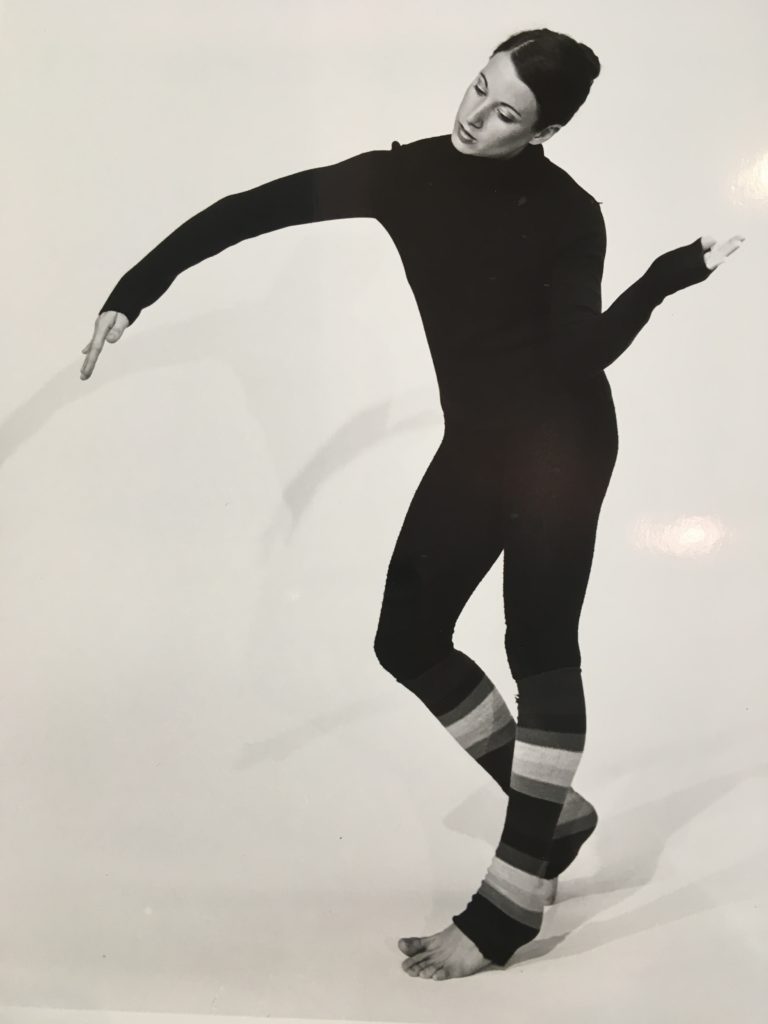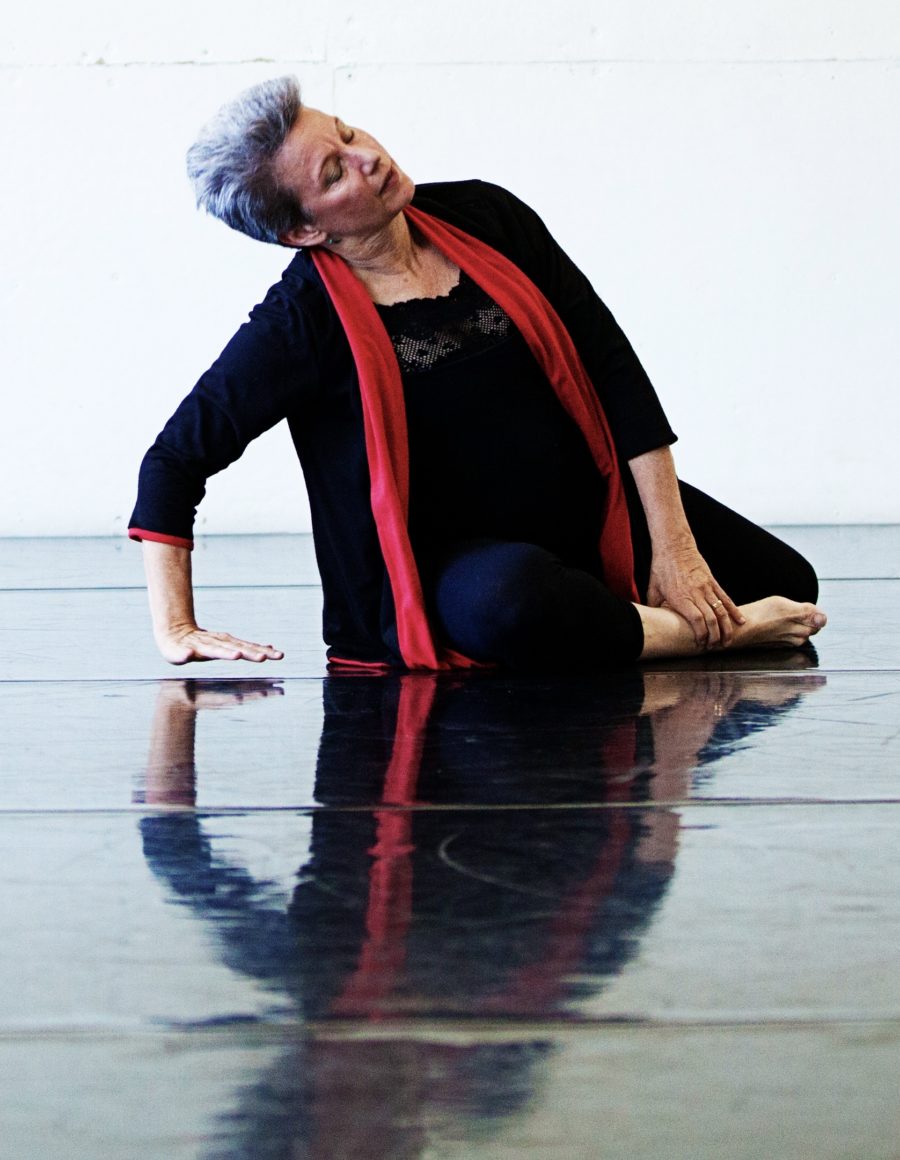Virginia “Ginny” Matthews practices what she preaches. She’s ordained in a Rinzai Zen Buddhist lineage as well as immersed in the dance community as a performer, choreographer, and teacher. The guiding Zen principle, “You deal with what you got,” has undergirded Ginny’s dance career for half a century.
The longest she has not danced is three months. This despite three pregnancies and three births. “I was going to take six months off after my second son was born. But my husband injured his arms, so I had to go back to teaching….I was also interested in how my body moved when it was pregnant.” This sense of curiosity and acceptance inspired Ginny’s upcoming concert, Approaching 70 – 50 Years of a Life in Dance – a retrospective of solo works from 1975 to the present – to commemorate her 70th birthday.
She can’t help worrying, “What am I doing? Do people really want to come?” But perhaps because she sits and meditates, she teaches class to keep in shape, and she emphatically loves to dance, she’s dealing with it. “I think I’m exploring the difference between a sense of exposure and a sense of transparency. If I start to feel like I’m exposing myself to people’s judgements, I don’t feel free. I feel inhibited. But transparency means I’m just going to show up and be as clear and transparent as I can be.”
Watching Ginny is delightful. Talking to her, too. As we say in both the dance and the consciousness worlds, she has a strong presence.
“I’m sensitive to electromagnetic waves. If you don’t have a practice that can help ground you, I worry for you – whether it’s dance, yoga, meditation, walks in nature, playing tennis every day, whatever it is that gets you back in your body. And in a quiet and still place. We need to keep that balance. My favorite thing is to just sit in my backyard and drink a cup of tea.”
Dancing at 70 years of age and older is relatively unexplored territory. Ginny hopes to help shape our ideas about this landscape. She wonders: Does an elder dancer bring something unique and valuable to the art form? Is the loss of youthful technical virtuosity balanced by a fuller and more mature artistic expression? Does maturity mean a more open and transparent persona on stage?
Ginny considers performing an essential component to a life in dance.
“If the ultimate goal of dance is expression, you have to have that framework to express. Our framework is performance. It doesn’t necessarily have to be in a theater or super formal, but it needs that – and this is where the interface with Zen is – it needs the present moment, time, and focus to live.”
My present moment, time and focus is a year-long fellowship, at the Global Brain Health Institute, at the UCSF Memory and Aging Center. I’m a middle-aged dancer and senior fitness instructor who’s exploring the intersection of dementia care, movement, and performance.
Aging is something everyone has in common. We’re all going there. What if we view aging as an experience that unites us? I have learned that people over the age of 65 often don’t get looked in the eye. How does aging effect our literal and metaphorical focus on the present moment?
As a fellow for brain health equity I’m learning that we should dance into old age. There are numerous studies that conclude dance is particularly good for brain health. (A good rule of thumb is to remember what’s good for the heart is good for the brain). But there is a lot of stigma associated with dancing while aging. I embody that tension. I’m 49 years-old, 20 years Ginny’s junior, and like Ginny I’m still dancing, teaching and performing. I asked Ginny when she crossed over into considering herself an older dancer. She thought about it for a moment and then said, “I guess around 2000.” I did the math. That’s my age.
The age of grace
“I was reading a book about old age,” Ginny told me over a snack of chai and trail mix, between class and rehearsal. “The one thing this man was trying to say was: we need elders. We have tons of old people who are addicted to competency. He said you need to step out of that role. Your role is to tell stories, to be further down the road, and maybe to be able to throw out a few pointers rather than wanting to still march side by side with your middle-aged self. He said he considers it a great insult when people tell him he doesn’t look his age.”
As she spoke I thought, I’m extremely grateful Ginny is going out on a limb with this production. Role-modeling for us younger older dancers.
First, I watched Ginny teach Modern Dance for the Returning Dancer, where participants ranged from older dancers to new mothers. Then I watched her run through a few solos that will be featured in 50 Years. I wanted to tell Ginny she doesn’t dance her age.
She still does center floor grand pliés, which Ginny identified as probably the toughest thing for people who are returning, hitch-kicks with ballon, Cunningham-esque unusual rhythms, and changes of direction. She has impressive balance. Ginny dances with precision and ease – with what I would call grace. Maybe its fairer to say Ginny does dance her age. She embodies a life-time of grace in every movement.
I asked Ginny if she felt she had any age-related limitations.
“What are your limitations and what’s your vocabulary?” she considered thoughtfully. “A writer may not access all the vocabulary, but they have a vocabulary that’s rich for them. I haven’t yet felt like I wanted to say something that I wasn’t physically able to do.”

Have Merce-y
Ginny told me a story that illustrates this limitation/vocabulary distinction. She saw Merce Cunningham perform with his company when he was quite arthritic. “He didn’t do much. He moved, positioning all these younger dancers, and then he’d go to the back of the stage where there was a coat rack and put on an old-man sweater.” He repeated the act with different sweaters. “And I thought, yes. He’s telling it like it is. It was very, very moving. Moving because he was moving even though he wasn’t moving the way he used to be able to. But he found a way to still be self-expressive.”
* * *
Ginny attended Sarah Lawrence College. She knew she wanted to go to an art school to follow music, theater, or dance. “I was the least skilled at dance.” But modern dance pioneer Bessie Schonberg was the director of the dance department at Sarah Lawrence. “She was a force of nature and I thought, ‘I want to study with her.’”
Ginny told me Bessie was a master at getting composition and creative self-expression out of people. Jerome Robbins and Merce Cunningham used to show her things because she had such a great eye. While watching a student-choreographed showcase the light bulb went on: “Oh, I could choreograph a dance.” After college Ginny trained at the Cunningham Studio. She furthered her Cunningham training in San Francisco as a founding member of the Margaret Jenkins Dance Company. “My time studying with Margy and performing in the company was a foundational part of my dance life.” Ginny has retained strong Cunningham roots in her teaching and choreography.
There’s a movement afoot to incorporate dance into treatments for neurocognitive diseases. Mark Morris offers a program called Dance for Parkinson’s Disease. Tango for Parkinson’s is gaining traction. I share an affinity for Cunningham technique with Ginny. (After taking my first Cunningham classes at the American Dance Festival I transferred colleges – moving to California to study with former Cunningham dancer Jeff Slayton). Might Cunningham technique bolster cognition?
In her Returning Dancer class Ginny uses Pilates to warm up the joints. “If we just started with the Cunningham exercises the joints would not be ready.” It takes longer for older joints, she notes. “Cunningham is actually very good for the aging body because it is very conscious. You have to know where your body is in time and space and relationship, so you’re less likely to fling yourself into injury. It’s also very good for the brain. I always make my students face in different ways than they would normally face, or go different directions. And that was Merce. That was part of your training with Merce, to be able to go anywhere anytime.”
I asked Ginny about the timing of 50 Years. Is it in any way connected to the Merce Cunningham centennial? Cunningham, who died in 2009, would have turned 100 this year, a milestone being celebrated by events, discussions and presentations.
“I’m turning 70 in September, that was that impetus. I thought it would be kind of cool to revisit this long span.” She worked with teenagers for 36 years; with mother-daughter pairs; for a while she taught people ages 5 to 65. “I was protesting against what I call ‘the ghettoizing of the ages.’ Kids in school doing their thing. Old people at the senior center doing their thing. Adults at home doing their thing. Why can’t we get together? I imagine that’s how villages and communities were. Everyone came together for a celebration.
Merce Cunningham once famously said dancing gives you, “nothing but that single fleeting moment when you feel alive.” Ginny mused on this remark. “I think what he meant is that you get to be completely focused, which we don’t get to be very often. I mean I actually do in my Zen training. But I’m not sharing, that’s my own personal practice. Performing is taking that practice and sharing it.”
This article appeared in the May 2019 issue of In Dance.


